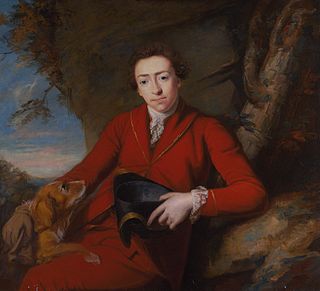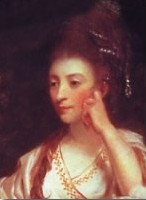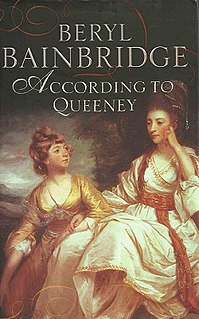
Samuel Johnson, often called Dr Johnson, was an English writer who made lasting contributions as a poet, playwright, essayist, moralist, critic, biographer, editor and lexicographer. He was a devout Anglican, and a committed Tory. The Oxford Dictionary of National Biography calls him "arguably the most distinguished man of letters in English history". James Boswell's Life of Samuel Johnson was selected by Johnson biographer Walter Jackson Bate as "the most famous single work of biographical art in the whole of literature".

Frances Burney, also known as Fanny Burney and later Madame d'Arblay, was an English satirical novelist, diarist and playwright. In 1786–1790 she held the post as "Keeper of the Robes" to Charlotte of Mecklenburg-Strelitz, George III's queen. In 1793, aged 41, she married a French exile, General Alexandre d'Arblay. After a long writing career and wartime travels that stranded her in France for over a decade, she settled in Bath, England, where she died on 6 January 1840. The first of her four novels, Evelina (1778), was the most successful and remains her most highly regarded. Most of her plays were not performed in her lifetime. She wrote a memoir of her father (1832) and many letters and journals that have been gradually published since 1889.

Streatham is a district in south London, England. Centred 5 miles (8 km) south of Charing Cross, it lies mostly within the London Borough of Lambeth, with some parts extending into the neighbouring London Borough of Wandsworth.

Charles Burney was an English music historian, composer and musician. He was the father of the writers Frances Burney and Sarah Burney, of the explorer James Burney, and of Charles Burney, a classicist and book donor to the British Museum. He was a close friend and supporter of Joseph Haydn.

Hester Lynch Thrale Piozzi, a Welsh-born diarist, author and patron of the arts, is an important source on Samuel Johnson and 18th-century English life. She belonged to the prominent Salusbury family, Anglo-Welsh landowners, and married first a wealthy brewer, Henry Thrale, then a music teacher, Gabriel Mario Piozzi. Her Anecdotes of the Late Samuel Johnson (1786) and her diary Thraliana, published posthumously in 1942, are the main works for which she is remembered. She also wrote a popular history book and a dictionary. She has been seen as a protofeminist.

Henry Thrale was a British politician who sat in the House of Commons from 1765 to 1780. He was a close friend of Samuel Johnson. Like his father, he was the proprietor of the large London brewery H. Thrale & Co.

Elizabeth Johnson, familiarly known as "Tetty", was the widow of Birmingham merchant Henry Porter, and later the wife of English writer Samuel Johnson, whom she predeceased.

Philip Metcalfe,, , was an English Tory politician, a malt distiller and a philanthropist.

The Tooting Commons consist of two adjacent areas of common land lying between Balham, Streatham and Tooting, in south west London: Tooting Bec Common and Tooting Graveney Common.

The Streatham Worthies is the collective description for the circle of literary and cultural figures around the wealthy brewer Henry Thrale and his wife Hester Thrale who assembled at his country retreat Streatham Park and were commemorated by a series of portraits by Joshua Reynolds.
Wandsworth was the name of a borough constituency created in 1885, abolished in 1918, covering the vast bulk of today's London Borough of Wandsworth in South London but excluding Battersea. It returned one Member of Parliament (MP) to the House of Commons of the UK Parliament.

Sir John Lade, 2nd Baronet was a prominent member of Regency society, notable as an owner and breeder of racehorses, as an accomplished driver, associated with Samuel Johnson's circle, and one of George IV's closest friends. While that monarch was still Prince Regent, Lade attracted high society scorn from the extent of his debts and his choice of marriage to low-born beauty Letitia, who was generally supposed to have been the mistress of the executed highwayman John Rann and the Regent's next-youngest brother, the Duke of York.
Mary Morley Eccles, Viscountess Eccles was a book collector and author. She was renowned for establishing one of the largest private collections of 18th century literature with her first husband, Donald Hyde (1909-1966). This includes works from Samuel Johnson and James Boswell. She also created an Oscar Wilde Collection which was bequeathed to the British Library in 2003. Her second marriage was to the British peer, David Eccles, 1st Viscount Eccles, with whom she co-founded the Eccles Centre for American Studies at the British Library in 1992.

The Thraliana was a diary kept by Hester Thrale and is part of the genre known as table talk. Although the work began as Thrale's diary focused on her experience with her family, it slowly changed focus to emphasise various anecdotes and stories about the life of Samuel Johnson. The work was used as a basis for Thrale's Anecdotes of the Late Samuel Johnson, but the Thraliana remained unpublished until 1942. The anecdotes contained within the work were popular with Thrale's contemporaries but seen as vulgar. Among 20th-century readers, the work was popular, and many literary critics believe that the work is a valuable contribution to the genre and for providing information about Johnson's and her own life.
The health of Samuel Johnson has been a focus of the biographical and critical analysis of his life. His medical history was well documented by Johnson and his friends, and those writings have allowed later critics and doctors to infer diagnoses of conditions that were unknown in Johnson's day.

Hester Maria Elphinstone, Viscountess Keith, born Hester Maria Thrale, was a British literary correspondent and intellectual. She was the eldest child of Hester Thrale, diarist, author and confidante of Samuel Johnson, and Henry Thrale, a wealthy brewer and patron of the arts. She became the second wife of George Elphinstone, 1st Viscount Keith.

William Seward was an English man of letters, known for his collections of anecdotes. he was closely acquainted in London with Samuel Johnson, the Thrales and the Burneys.

According to Queeney is a 2001 Booker-longlisted biographical novel by English writer Beryl Bainbridge. It concerns the last years of Samuel Johnson and his relationship between Hester Thrale and her daughter 'Queeney'. The bulk of the novel is set between 1765 and his death in 1784, with the exception of the correspondence from H. M. Thrale (Queeney) to Laetitia Hawkins from 1807 onwards, at the end of the chapters.
Marianne Francis (1790–1832) was an English evangelical, now known principally as a correspondent of Hester Piozzi and Sarah Wesley. She has been called an "evangelical bluestocking", and is recognised as a significant participant in debate about religious enthusiasm.
















